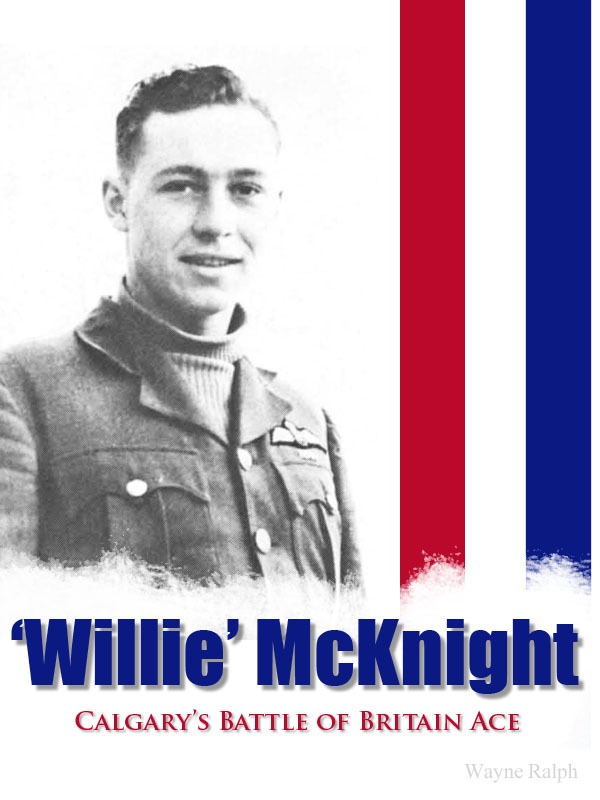

One of the most distinguished aces of that early period (1939-1940), William Lidstone "Willie" McKnight, was born in Edmonton and grew up in Calgary, Alberta. He had enlisted in February
1939 and started flight training in England at No. 6 Flying Training School (FTS), Little Rissington, Bourton-on-the-Water, Cheltenham, in late April. McKnight's letters to friends back
home (held by Library and Archives Canada in Ottawa) reveal a self-confident, argumentative scrapper, sure of himself and his flying abilities and forthright in his opinions of those around
him. Typical of many future fighter pilots, he conflicted with RAF authority. Despite or because of his obvious potential, he lacked the appropriate humility expected of a novice. He was
confined to barracks for fourteen days at least twice, and he and a classmate were put on open arrest for "being perpetrators of a riot."
Willie McKnight had left behind a girlfriend named Marian in Alberta whom, in his own opinion, he had treated badly and whom he missed very much. Even though she might never see him again
or even wanted to talk to him, Willie believed that he was changing and hinted in a letter home that perhaps Marian, with whom he had had a tumultuous relationship, would approve of the new
person he was becoming.
After September 1939, life became much more serious for McKnight and his classmates. The RAF stopped being akin to a flying club and went on a seven-day-a-week work schedule that allowed
limited sleep, bad food, and stomach upsets. The latter were caused by the bad food to which the Canadian fellows were more susceptible, or so McKnight declared.
In November he arrived at 242 Squadron, a newly formed, predominantly Canadian-staffed RAF squadron commanded by an RCAF squadron leader on exchange with the RAF. During the quiet period of
the so-called Phoney War, 242 trained for operations, not flying sorties until March 1940 and not fighting its first successful battles until May 1940 in the skies of France.
McKnight scored the first victory for 242 Squadron on May 19 over Cambrai, France, in a region much disputed by Canadian fighter pilots during the First World War. All through the Battle of
France and the Battle of Britain, he demonstrated again and again his natural talent for aerial combat, achieving about eighteen victories flying a Hurricane. He became an ace with five
victories in a mere ten days, between May 19 and 29. His friendly rivals for top score at 242 were, first, Stan Turner, and then, with his arrival to command 242 on June 20, Squadron Leader
Douglas Bader.
Bader was quoted in Reach for the Sky (Paul Brickhill's biography of Bader) as saying that McKnight was a great fighter pilot, with "flinty eyes." In Bader's opinion, he was
characteristically Canadian: fearless and aggressive. Bader recalled that McKnight had a taste for romantic music, and insisted on playing and replaying his large collection of Bing Crosby
records in the evenings in the officer's mess.
There is no doubt that the realities of war, combined with his drive to excel, aged Willie in a few burning months. Operations over France and over the English Channel eliminated his
lighthearted banter in letter home. In February 1940 he complained to H.F. "Mike" Pegler of 1221 5th St. in Calgary about night formation flying in the Hurricane:
It's the most hair-raising thing I've ever done. Before the war you could use the navigation lights of the leader as a mark to formate on but as we're not allowed to use navigation lights we
have to use the exhaust flames as a guide. Most of us have grown half a head of grey hair since we started and we hope never have to do it again once we've got it "buttoned up" ...I've been
made a section leader which means I lead one formation of three machines in the flight (there are six in a flight) and it sure is good fun except I'm not so keen on the responsibility. It's
alright but I'd sooner be No. 2 in a formation any day where you've got the best position and only half the responsibility.
The first time that McKnight saw a corpse up close was at RAF Station Church Fenton, Tadcaster, Yorkshire.
We had a rather unfortunate accident here the other day - one of our new Canadian corporals was leaning against the wing of one of the machines when an armourer inside the cockpit pushed the
gun tit and blew the top of his head off. It sure made a mess of him, so now they've fitted a few more safety devices to our remote control button just to make it harder for us. Every time
some dumb airman pulls a trick like that they make it harder for the pilots to use the guns when he needs them. I was the first officer around after the accident and got one perfectly good
tunic spoilt with blood and brains splashed all over it.
McKnight's letter is by no means unique. Young men writing letters home from the war often had an impulse to shock. The same can be seen in letters of pilots in the First World War. It
likely is a method to dissipate the horror of being a witness to wartime events.
In the few weeks of the Battle of France, McKnight lost twenty-seven pounds. He recounts in a letter to his childhood friend Mike Pegler that "I almost looked like an overgrown kid when we
arrived back in England." In addition to fighting, McKnight found time to have a short affair with a young woman who had escaped Paris ahead of the German army and, like thousands, was a
refugee on the run to an unknown future.
The brass hats pulled out so fast we all had our own private cars. This girl and I, her name was M___, took a flat in Nantes and had a hell of a time for about two weeks. All the boys kept
dropping in every night and we'd all B.S. and listen to the radio and eat then bog off to bed (after the lads had gone). It was sure marvellous and I certainly miss it now - I tried to
smuggle the girl back on one of our bombing planes but one of the few big noises left in France caught me and raised merry hell. It was too bad because she was certainly one first class
femme - she had been to university and was a modiste until the Hun started toward Paris when she had to evacuate and then I ran into her. Oh well, I suppose I must have been fated for a
bachelor - I can't fall in love anymore like I used to; I get all worked up for about an hour then I just lose interest.
After the battles in France, he was admitted to hospital in July 1940 for a rest. While recuperating he wrote:
I've been sick in bed for four days now and today is the first day I've been allowed to do anything at all and the MO even put a time limit to writing letters. Everything seemed to go wrong
with me all at the same time, stomach, ears, throat, eyes, etc., or in other words I was more of less useless to anyone. The Doc says it was almost two months of no sleep and less food that
did it then sort of coming back to a civilized life just floored my system and I was left sucking a hind tit. I should be out in another four or five days though I hope so as the "Blitz" is
just starting again and I've got to keep Turner from hogging all the fun. We two are the high scorers in the squadron so far, having got twenty-three between us - nine for Stan and fourteen
for me - as we have a pretty keen competition going on and neither one of us likes to be off duty when the other one is on and we're both afraid we'll miss a chance to get something...
It's a funny thing this fighting in the air, before you actually start or see any of the Hun you're as nervous and scared as hell but as soon as everything starts you're too busy to be
afraid or worried. We've had several fights with Colonel Schumacher's squadron - its supposed to be in the same class as Richthofen's was in the last do - and I don't mind saying that
they're about the finest pilots I've ever met... some bloke who must be the personal ace of the Luftwaffe jumped me and succeeded in shooting away nearly all the machine except where I was
sitting before I managed to dive into a cloud. Well anyway after we got home (three out of five) we found out that about eight Jerry squadrons had pooled their resources for the morning and
we'd tried to jump about eighty machines. We laugh like hell when we think about it now but it wasn't so funny then... We've only got five of the original twenty-two pilots in the squadron
left now and those of us who are left aren't quite the same blokes as before. Its peculiar but war seems to make you older and quieter and change your views a lot in life - you also find
out who are the blokes worth knowing and who aren't and I haven't met one yet who wasn't worth knowing.
By September 1940, now with a DFC and Bar, Willie had developed a sophisticated insight into how war had changed him inside and also separated him from his past. It had mutated him into a
warrior with little connection to what he left behind in Alberta. He mused about his future:
I suppose I shall remain here until the end or until the other end. I've got so used to the thrill and the, I don't know how to express it, final feeling of victory that I'd feel lost and
bored by a quiet life again. This war business changes people a lot and I'm sure you'd never believe that people were one and the same if you meet them again after a year or so's constant
"dicing with death."
On January 12, 1941, Willie McKnight went missing near Gravelines while on a low-level "Rhubarb" attacking a German E-boat in the Channel. Rhubarbs were typically two pilots, two aircraft,
flying at low altitude and high speed to coastal areas of France or Belgium looking for targets of opportunity. Rhubards were dangerous and not every fighter pilot did them (as one veteran
observed to the author, "It appealed to pilots light on brains and heavy on courage"). Willie and his wingman, Marvin Brown, were fired on by very accurate anti-aircraft gunners, and then
apparently bounced by an Me109. McKnight and Brown were separated. Brown made it home; McKnight disappeared. His body was never found and the circumstances of his death are uncertain. We
don't know whether he was killed by a flak gunner or one of the Luftwaffe's finest aces, the kind Willie wrote about in his letter to Pegler. Had he lived McKnight might very well have been
Canada's highest-scoring fighter pilot of the Second World War. Today, a boulevard near the airport in Calgary is named for him.
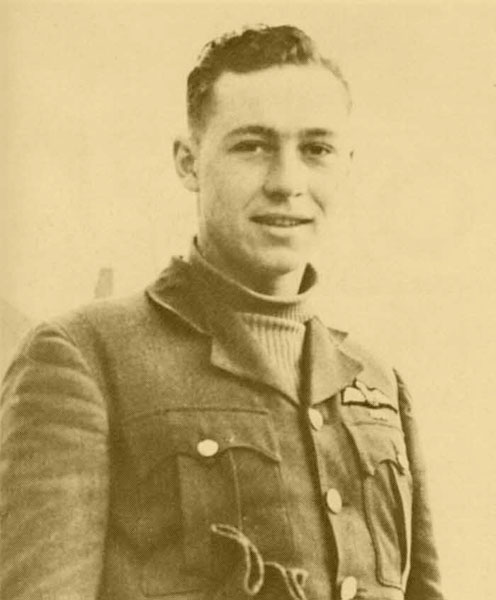
Son of a grocery store buyer, William Lidstone McKnight, became Canada's second fighter ace, and by the war's end, would rank as the seventh highest Canadian ace. (Imperial War Museum)
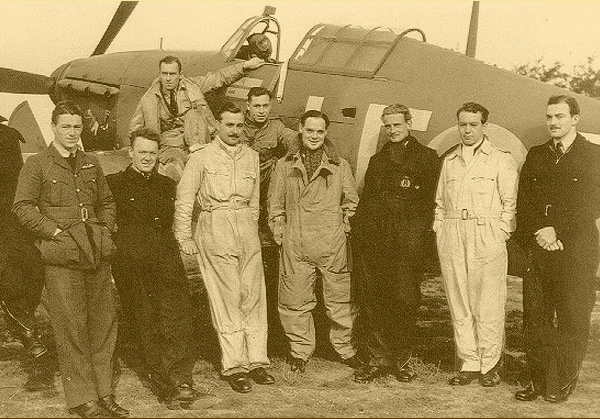
Members of 242 Squadron pose in front of Bader's Hurricane (the flash beneath the canopy is a Squadron Leader's insignia). S/L Bader stands in the centre, with Willie McKnight kneeling behind his right shoulder. (Imperial War Museum)
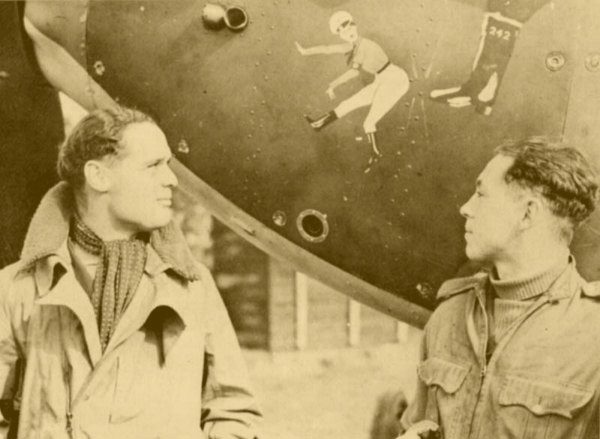
Squadron Leader Douglas Bader (left) and Willie McKnight (right) pose in this staged photograph, looking at the artwork of 242 squadron's boot kicking Adolf Hitler. After the war Douglas Bader would become head of Shell Petroleum's aviation department, and would visit Calgary on several occasions. The legendary pilot's reputation certainly assisted in the naming of two important roadways near the airport in honour of Calgary's 242 Squadron members, William McKnight and Neil Barlow. (Imperial War Museum)
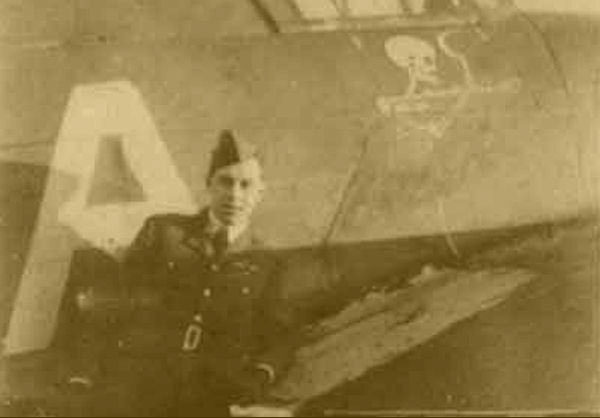
In 70 years there have only been two photographs to surface showing McKnight's Hurricane, LE*A. Both are tightly cropped and primarily show McKnight's grim reaper nose art, which he applied himself. As a failing medical school student, McKnight decided to leave his troubles in Alberta and join the RAF in England.
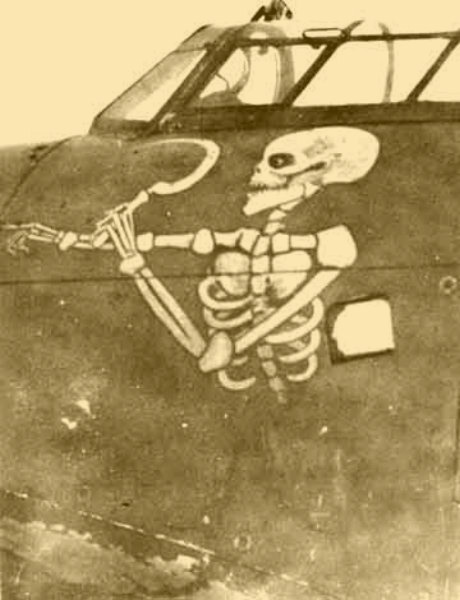
One of the results of McKnight's unique nose art, and his station as fighter ace, has been to make his Hurricane one of the most replicated Hurricanes in existance. From paintings, to scale models of all sizes, and at least one real Hurricane, McKnight's markings can be found everywhere. As recently as 2012, an Italian scale model maker has included McKnight's markings in their kit.
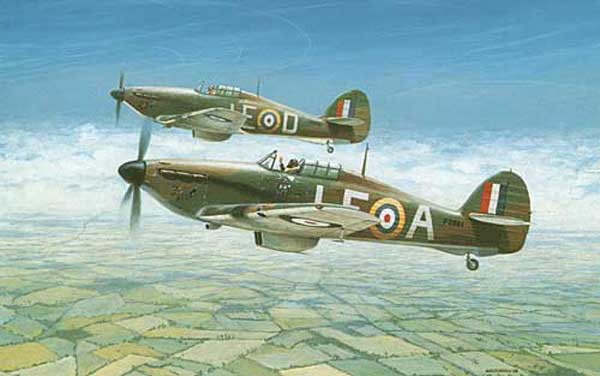
Michael Martchenko's painting, McKnight's Hat Trick, is one of the most famous depiction's of 242 Squadron's greatest aces - Willie McKnight and Douglas Bader - as they return to base to celebrate their victories on August 30, 1940; Bader 2, McKnight 3, the rest of 242 Sqn 8; all without loss to themselves.
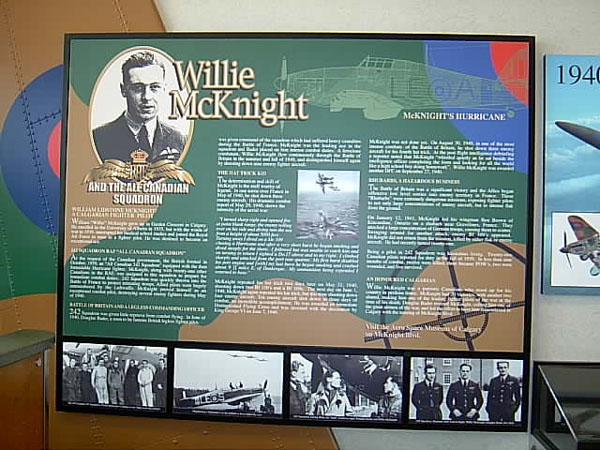
Passengers waiting for their flights in the 'D' (WestJet) wing of Calgary's International Airport terminal can pass the time learning about their hometown hero through this storyboard prepared by the Aerospace Museum of Calgary.
References:
Aces, Warriors & Wingmen by Wayne Ralph
John Wiley & Sons Canada Ltd.
Copyright 2005